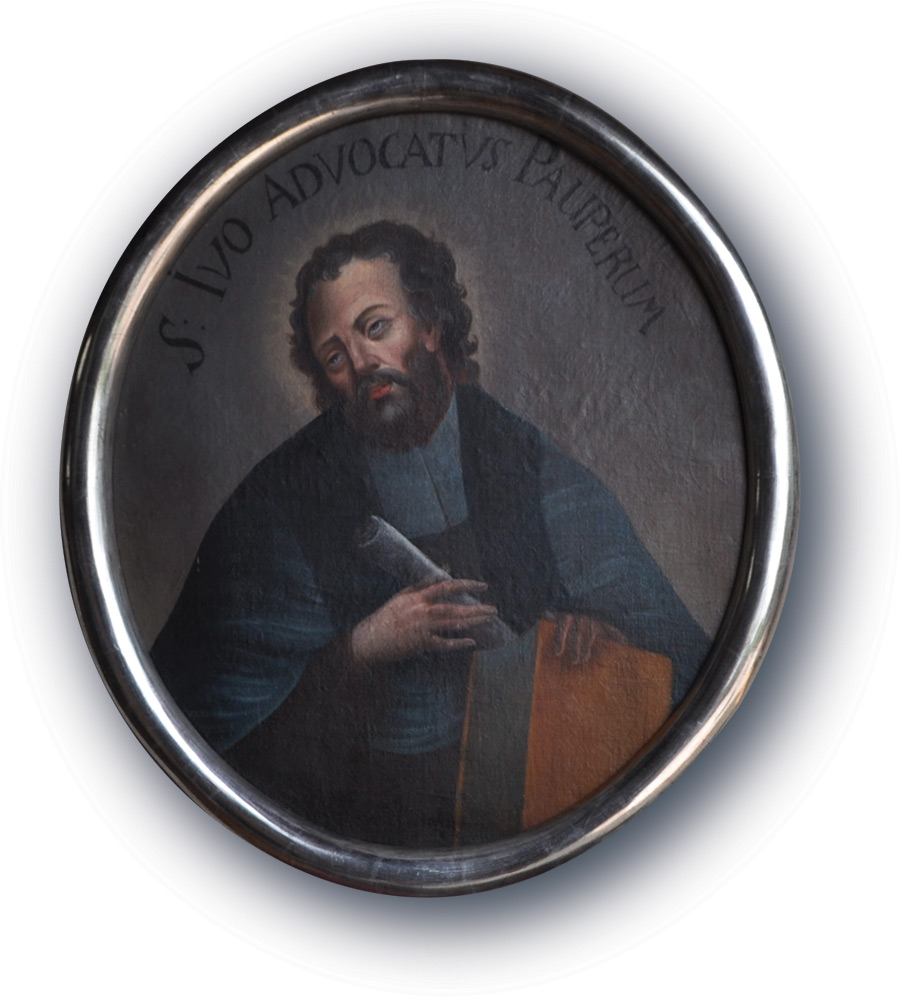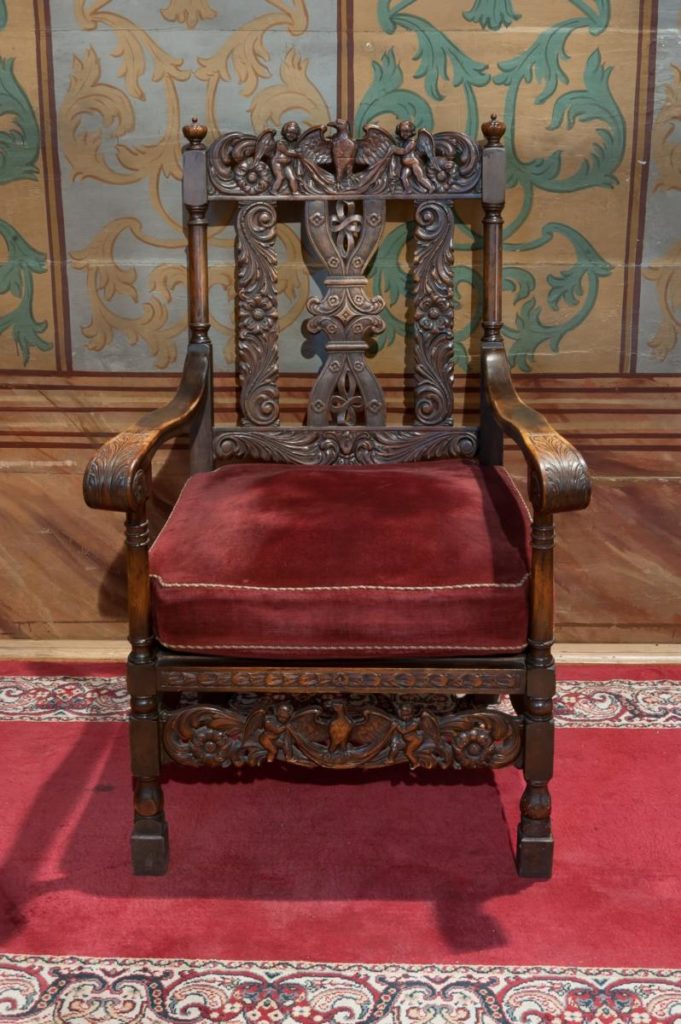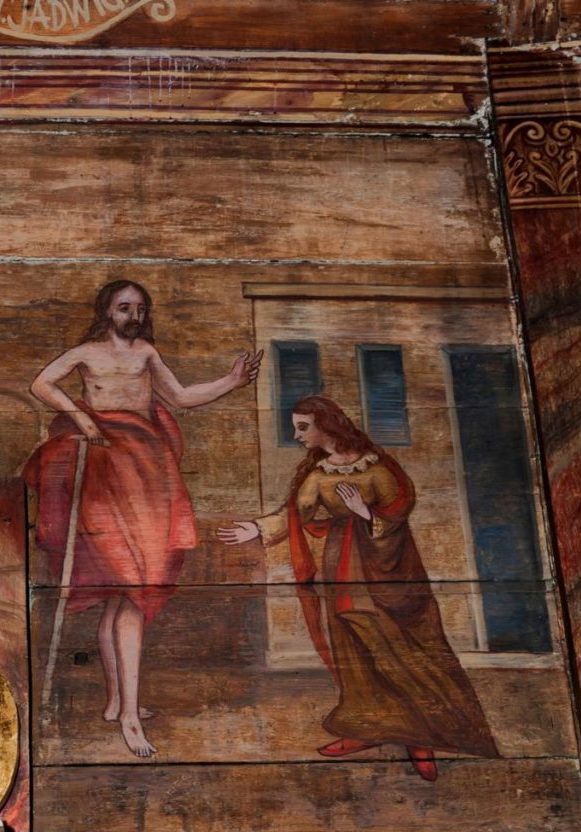Wooden monuments
Christ has resurrected
A special artwork kept in the church is a full statue of Resurrected Christ. Dated to the half of the 18th century it has typical Baroque style elements (such as characteristic draping of the robes). Unknown artist, possibly inspired by religious texts connected with Easter, created the figure of the Saviour. To emphasize the effect of a “living” statue, the work was polychromed and then gilded (the crown and the hip band).
- The gold crown – the symbol of royal power of Christ.
- He is giving blessings with His right hand.
- According to the Easter song from the Middle Ages, “Christ is resurrected” and “holds a banner in His hand” (as a sign of victory over death).
- The purple coat on His shoulders is the symbol of blood, fire and saving torment which is reminded in the text “Lenten Lamentations”: ”Dressed in a scarlet garment (…) mocked”, “dressed in purple robes, sceptered with a reed. Mercy He doeas plead”.
- Christ is standing on the globe as the Ruler of the Universe.


Untypical saints
Three oil paintings also deserve attention. They present untypical saints. The first of them in Benon, who probably was the patron saint of farmers and breeders from Sośnica:
“Because you are in the care of cattle extremly experienced (…) Let the wing of your care protect our cattle from disease; you farm, and we like farm workers, your servants”.
Church Songbook, Poznań 1894
The patron saint is shown in bishop’s clothing. He is giving blessing to the pair of farm animals with his right hand. An ox and a cow are attributes of Benon which he can be identified by. There is a country landscape in the background – the place of work of the patron saint of cattle breeders.

In the side altar of the Crucifixion, with the cross in the main quarter, a tondo with the image of St. Lutgardis is put. She was a Flamish nun of the Cistercians order who lived at the turn of the 12th and 13th centuries. As a small girl she had the first of many visions of Christ. She joined the convent and quickly became the abbess while experiencing numerous supernatural epiphanies. She eagerly promoted devotion to the Sacred Heart.
Women parishoners from Sośnica probably prayed to her during giving birth because St. Lutgardis help was invaluable then. Apart from this, the patron saint also takes care of the blind and the handicapped.
- Crucified Christ gives His blessing to St. Lutgardis with His right hand ‘detached’ from the cross.




Opposite St. Lutgardis there is the second, left side altar. There is a painting of the Archangel Michael in the centre and above him a tondo with the image of St. Ivo. St. Ivo was a lawyer who lived at the turn of the 13th and 14th centuries and who was a member of the Third Order of St. Francis. Even though he had a high social status as a diocese judge, he also took care of the poor, widows and orphans.
- St. Ivo is holding his attributes: a book and a pen.
- Above the patron saint’s head there is a sign in Latin: “St. Ivo the lawyer of the poor”.
Feretrory
Among historical objects which are worth paying attention to, but seen only during processions, is a feretory. It is a portable, double-sided religious painting in a decorative frame. The scene is usually painted on a metal sheet and put in decorated frame. Feretories always have rectangular base with holes for bars so that they can be carried. Those historical objects are connected with processions, which are manifestations of faith expressed in the public space. In the feretories in the church in Sośnica, which are characterized by folk stylistics, we can find images of Christ the King and St. Anna Metterza among others, as well as images of St. Joseph with Child, Madonna of the Apocalypse or Michael the Archangel.




The seat of celebrant
The seat is traditionally placed in a sedilia which is a place in church for the celebrant and service assistance found usually in a chancel. Sedilias were put by the wall. With time the seats took a shape of a throne, especially the one designed for the celebrants. A priest sits there during liturgical singing by the choir or during readings. The new service requires that the celebrant’s and his assistance’s seats are placed so that the faithful see that the celebrant leads the service’s community.
The seat for celebrant in Sośnica is characterized by a very sophisticated design. Vivid imagination and artistry of a woodcarver are seen in the carved details of the seat. It is decorated with flowers and a pair of angels which are supporting an eagle on a shawl.

Trifoliate cross

The sculpture of crucified Christ is almost 250 years old and it was made by a folk artist. A characteristic cross, the arms of which are culminated with a trifoliate clover, draws attention. This image is usually interpreted as a symbol of the unity of the Holy Trinity. The expression of depiction of Christ is characteristic for the Baroque period: a muscular body, a distinct curve of the figure and typical presentation of the perizoma which is a loincloth around hips, relatively tight and tied on the side around a rope in a sophisticated way.
The female apostle of the apostles
The patron saint of the church is St. Mary Magdalene, whose life from the Bible is depicted on the church walls. The second name of the saint stems from the name of the town where she came form – Magdala. She belong to the group of Jesus’ disciples. She joined Him when seven evil spirits were drawn out of her. Polychromy from the church in Sośnica shows scenes known from the Gospel: we can recognize the story of washing Christ’s feet with tears and drying them with hair, another scene shows Mary Magdalene standing alone and holding the cross with Christ, and the moment of the meeting Christ after the Resurrection while she was carrying oils to the tomb. All four Evangelists claim that she was the first who came to the tomb and witnessed resurrection.



Mary Magdalene is worshiped as equal to apostles. She was set as an example especially to women of a convert. In 2016 in accordance with the will of Pope Francis, attention was drawn to the role of the saint in presenting the dignity of women and their function in the evangelistic activity of the church. It was reminded that St. Gregory I called her a “witness to God’s mercy” and St. Thomas Aquinas “the female apostle of the apostles”.
Indulgences
niedziela przed lub po 22 lipca (św. Marii Magdaleny) oraz I niedziela września (Matki Boskiej Pocieszenia)





